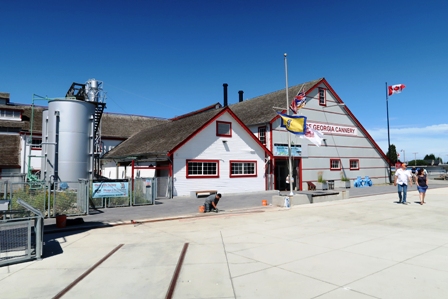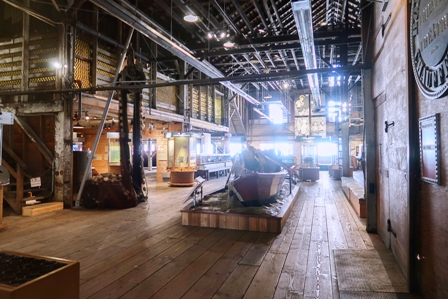CANNERY ROW - CANADIAN STYLE
The Gulf of Georgia Cannery Museum, Richmond, B.C.

Photo:Wikipedia
I was skeptical when advised to allow at least an hour to go through the Gulf of Georgia Cannery museum in Steveston, in Richmond, a suburb of Vancouver. My information sheet said it was built in 1894 and that after it closed its doors in the '70s, it was designated a national historic site. It now operates under the umbrella of the federally administered Canadian Parks Service and under the auspices of the Gulf of Georgia Cannery Society. it has been open to the public since 1994. Notwithstanding all that, in my book, a cannery was a place with assembly lines and machinery, a few photos and dry facts and statistics on charts displayed alongside a collection of old artifacts. Worth about 15 to 20 minutes at most. That was what I thought until I stepped inside and found myself drawn into a dynamic, multimedia experience that was sheer entertainment. Where else can you step onto a huge weigh scale and find out what your value would be if you were a salmon? Or walk through a model fishing trawler and take a look at the crew's living quarters - and (no spoiler here!) snicker at one of its occupants. Or stick your hand into a bucket of bloodied fish entrails which isn't real, but you'd never know the difference except that it doesn't stink. Smel, in fact, is one of the few sensory experiences you won't have when walking through the Cannery. But even that isn't hard to imagine when you visualize the boats disgorging their cargo at the wide entrance of to the Cannery back in the 1920s, when the entire area was waist-high in fish. The sights and sounds of the fishing industry are evoked vividly on the audio-visual screen, and as you walk along the canning lines, sensors trigger sound effects: the clank of machinery, the noise and confusion of everyday working conditions. In the butchering hall, 30 Chinese workers would skin and gut 16,000 to 20,000 fish a day, sometimes working around the clock (no refridgeration in those days) when the catch was large. The Chinese crews worked on contract and were paid one cent per 1,000 cans off the production line, earning between $35 and $50 a month. Not a bad seasonal wage in those days. In 1946, manual fish butchering was replaced with a mechanical gadget, then known unabashedly as The Iron Chink. It is still in use today, relatively unchanged, except for the name. In deference to politically correct terminology it is now more called The Iron Butcher, and is capable of cleaning, de-gutting and skinning 60 fish a minute. The Cannery offers something for all ages: small hands can open drawers and peek at artifacts, push buttons to watch audio-visual shows, turn cranks and pull aside flaps to reveal secrets of the ocean. Adults will marvel at the human drama and shared camaraderie of the people wo lived, loved, worked and died here. A charming 20 minute film, A Journey Through Time, is an old fisherman's tale as told to his young granddaughter, and plays in the surround-sound Boiler House Theatre within the museum building.
More information: http://gulfofgeorgiacannery.org/ Location:
12138 Fourth Ave, Richmond, BC V7E 3J1
|
